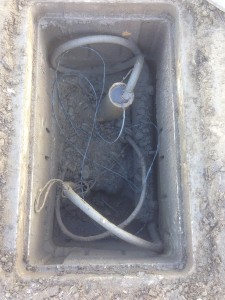Yes, I’m back. Sorry for the long absence…I’ve been swamped with a variety of life events, some good and some not so good. Yet in all things, to God be the Glory.
So, what is outside plant (OSP) cable? Well, it’s cable designed to be outside (or perhaps underground), exposed to the weather. The copper or fiber strands are surrounded by a very thick and hard plastic covering, and certain types of OSP cable contain a jelly filling, which would ooze outwards in the event of a tiny hole and not allow water in. Very cool.
At one of my remote sites, we have a 100 pair copper cable that feeds both data and voice services to another building about 1500 feet away. This cable was installed many years ago, and has a number of splice cans along it’s path. Over the last year, the cable has deteriorated substantially, and keeping the many analog lines up and running is almost impossible. (This site is still a large user of faxes and modems.)
Here is one of several pull boxes located along the path…note the conditions of the vault and the splice can located on the right side…
So I hired a vendor to remove the entire 100 pair cable, and install a new 50 pair cable in one long continuous feed, no splice cans at all. The vendor is also going to clean out all of the vaults and layer in some gravel to aid in drainage. We start at 3 PM this afternoon, working until sunset, and will return tomorrow morning. We hope to have the whole project completed by Saturday afternoon.
Some of you might be wondering why I’m going with a smaller, 50 pair cable, and not another 100 pair. Well, the 100 pair cable was installed way back when every desk phone required it’s own pair of copper. Back then, all of the phones were fed through this 100 pair cable. Plus we had multiple T1 circuits for data needs too. Now, though, our phone system is Cisco VoIP, which is handled via the data network and a single PRI circuit, plus the data T1’s have been replaced by a separate fiber network, so the need for 100 pairs is not there, and will never be there. A 50 pair cable is smaller, cheaper and easier to pull, and it will give us plenty of spare pairs if our needs grow.
I will take pictures of the process and will let you know how it goes in a couple of days. Have a great weekend!!

